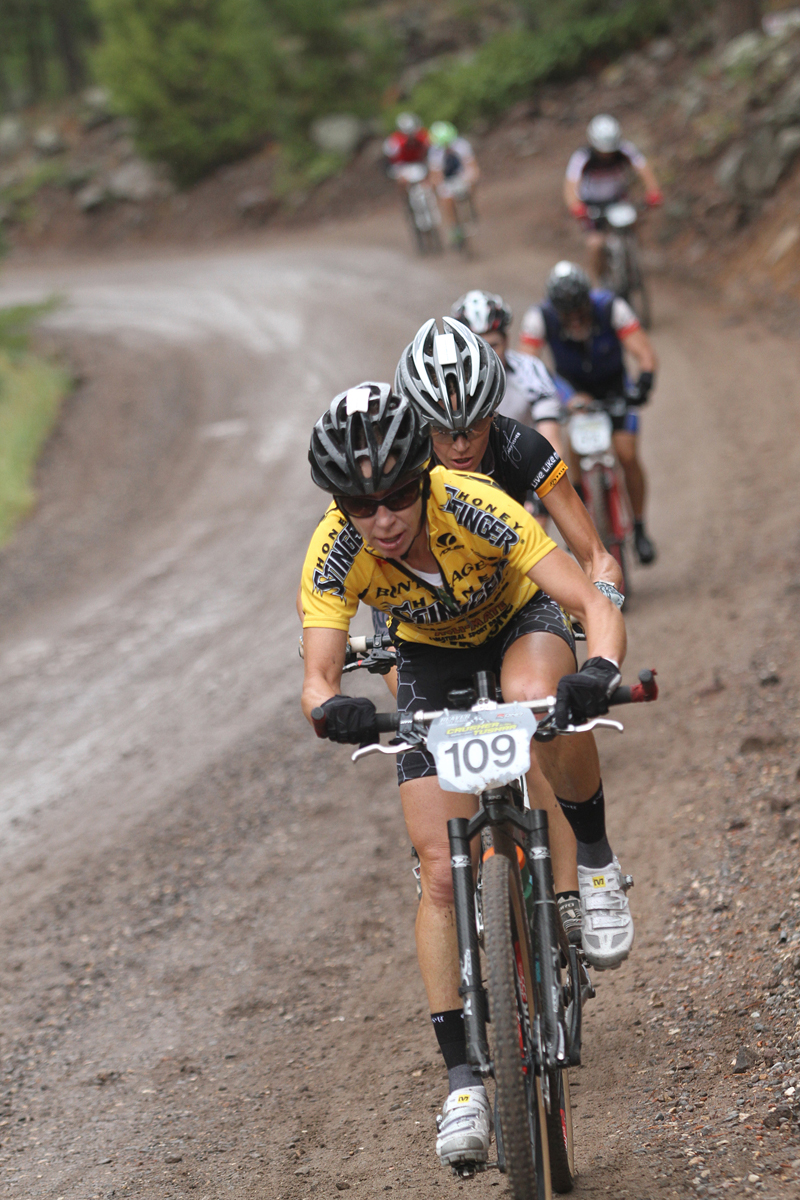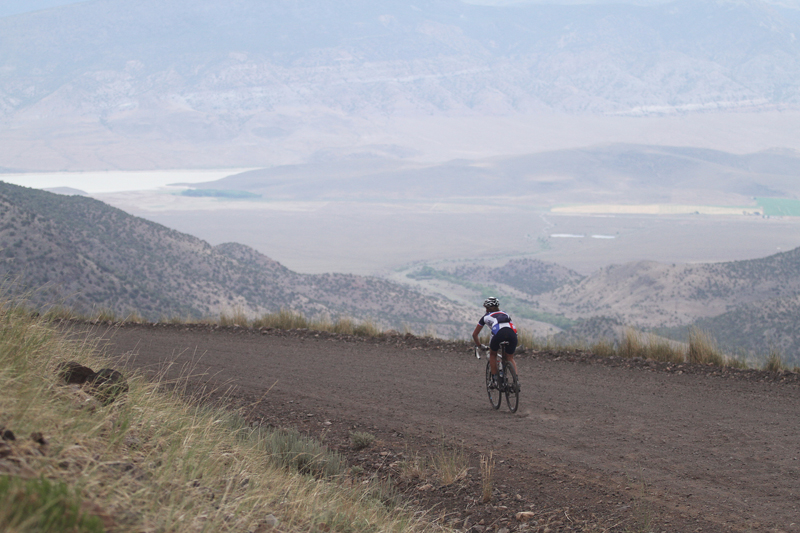Black clouds swirled overhead. Thunder rumbled in the distance. Enormous, heavy rain drops started to fall from the sky. They thudded against the ground, splashing into the dust and gravel of the forest road. I hurried back to the truck, trying fruitlessly to dodge the rain. The heavens opened in earnest, and the rain began to fall in sheets just as I slammed the doors of the truck shut. The water pelted loudly against the windows and roof. I sat for a moment and watched the fury of the storm.

I was somewhere near the top of Grindstone Flat in the Tushar Mountains. It was the evening before the 2nd annual Crusher in the Tushar, a 70 mile hybrid of dirt and pavement, mountain and cyclocross bikes, mountain bikers and roadies. “The Crusher,” explained Kenny Jones, “is the bastard child of road racers and mountain bikers.”

As the rain continued to fall, I thought about the next day’s adventure. Would there be rain like this? Did I have enough rain gear? Did I even bring rain gear? Were my tires going to hold up? And what about my legs? Had I done enough to get them ready? So many questions. So much anxiety. The rain only exaggerated the uncertain feelings and the second-guessing. I had done the inaugural Crusher in 2011, and yet, this second edition felt as mysterious as the first.
But I was not alone. The Crusher breeds anxiety. “I fret and brood about each race for days,” confessed Heather Gilbert. “Even when there are no decisions to be made except whether I am going to show up and pedal, I twist myself into knots with self-doubt.” But the Crusher isn’t like any other bike race. It demands guessing and second-guessing. Which bike? Which tires? What about cassette size? “And this race?” continued Heather, “This mostly-dirt–climbing-but-with-a-wicked-bumpy-descent-and-a-long-stretch-of-flat-pavement-race? My insides are churning.”
Heather and Kenny rode the Crusher on single-speed 29er mountain bikes. Which, in addition to increasing the difficulty of the actual pedaling (the Crusher does climb 10,300 feet in those 70 miles), amplified the chorus of doubt and confusion with the all-important single-speed riddle of which gear ratio. “This question brings all of my anxieties bubbling to the surface,” Heather said. “How strong are you, really? How much pain are you willing to endure?” Kenny explained the riddle as simply as possible: “I had to figure out one gear that would accommodate the flat sections without killing me on the climbs.” Heather decided that a 32:22 would be her gear of choice. Kenny, feeling Herculean, and having the pedigree to justify it, ran a 33:16.
However, unlike a standard mountain or road race, the question of gears was not limited to single-speeders. All of us were wondering about the size of our cassettes. And each of us were wondering exactly how much pain we’d be able to endure. Heather’s question echoed silently throughout the field, from the pro riders to the hobbyists in the back of the peloton, “How strong am I, really?” The Crusher has a way of answering that question in stark, black ink.
The climax of the Crusher is the Col d’ Crush. The race required us to descend and climb the twisted, graveled, and laughably steep dirt road. More commonly known as Highway 153, the Col d’ Crush is an access road connecting the Tushar mountains and the Paiute Valley, home to the small Utah hamlets of Junction and Circleville. The unpaved portion of the Col d’ Crush claims only 6 (3 up, 3 down) of the Crusher’s 70 miles. But it monopolizes all of the racers’ attentions. Indeed, The Col d’ Crush is the headwaters of the River of Doubt that flows easily through the hearts and minds of the racers. To be fast going down this crooked, deceitful road, a bike ought to have fat tires and suspension. But to climb it with any semblance of speed, a bike should be sleek and light. And forget about an “all-rounder” or any kind of compromise. The Col d’ Crush despises compromise. Whichever bike you choose, and whichever tires are glued to that bike, that choice will, at some unexpected moment, be horrifically wrong. Alas, that’s the Crusher. But that’s also why the 2012 edition was a sell out, and why every one of the 350 bike racers had been tied up in knots for weeks.
The morning of the race finally arrived. The motel I stayed at in Beaver, Utah was crowded with Crushers. We crammed food down our throats, trying to ignore the sick void in our guts. We joked a little, hefted each other’s bikes, and wished each other good luck. And then it began to rain. Hard. All the doubt and fear turned to enamel as we made our way to the start line. We each tried our best to hide our terror behind stupid grins.
“3… 2… 1… Go!” We were off. Into the gloom, into the mountains. Into the unknown.
When it was finally time to pedal, the second-guessing stopped. The fear washed away with the pouring rain, and the anxiety became excitement. The complexities of preparing for the Crusher in the Tushar were gone. All that was left now was the pedaling. “Something I always seem to understand during the race, but can never remember in those anxious moments preceding a race,” explained Heather, “is that my fears and concerns are little things, too evanescent and human to impinge upon the immeasurable cycle of the world. I am pedaling my bike. And I am happy.”
Pavement, glistening in the morning rain, became dirt. The peloton strung out across the mountain in a colorful procession of speed and ambition. Spectators rang cowbells, troops of Boy Scouts lined up for high-fives, the trees dripped with rain. Our breath was steam in the chilled mountain air. The dirt road was a sticky, rich brown. A slow river of gooey chocolate. And still, we climbed.
The rain stopped. But the clouds lingered. The wet mountains were fragrant, fresh. The air was cool and clean. Summer rain, at 10,000 feet. The ache of the climbing seemed to diminish as the sun rose and burned away a few of the misty clouds. Or was the grade of the road simply becoming more gentle? Nevertheless, riders sped energetically through the pine forest and around the bending, ascending roads until at last, there was nowhere left to go, except down. Down, quickly, and abruptly. 24 miles of climbing would be entirely eliminated in mere minutes of descending. My grandma used to to give me $5 for my birthday. “Don’t spend it all in one place!” she’d say. But my grandma never descended the Col d‘ Crush. All the morning’s effort, all that climbing, and every one of those pedal strokes, were about to be obliterated in a dizzying, tooth-rattling, arm-numbing, brake-burning, plunge.
“I loved going down.” Heather said, “I raced down the bumps, caroming from scenic viewpoint to scenic viewpoint, ever so pleased with my decision to be fat and squishy today.” My cyclocross bike and its narrow tires, on the other hand, were neither fat nor squishy. The washboards on the road were remarkable in their consistency, spaced exactly and perfectly apart to cause a bicycle to suffer the maximum rattle and shake. We all skidded and slipped across the road as we made our way down into the valley below.
“As I rode toward Circleville,” Heather recounted, “the flat section unrolled in front of me, accelerating me toward some distant horizon that I never actually got to. I coasted, and then pedaled madly. Am I not any closer to Circleville?”
Eventually Circleville came, and went. And so did the miles of prologue that preceded the ascension of the Col d’ Crush. After 50 miles, there it was, staring down at us like some kind of enormous, indifferent petrified hulk. There was nothing to do but pedal. Slowly, so slowly. Upward. I did my best to turn my cranks, but it was not so much turning as it was churning, as if I were trying to pedal my way out of a barrel of thick cream. Up. But only barely. When I got off my bike and walked, I knew that the pride and pomp that each of us bike racers has (else why would we even try something like the Crusher?) was gone. But I didn’t care. The moment’s objective—elevation—had little to do with panache or pride. The other riders around me were silent, each content to suffer in his own solitary prison of pain. We were, to a man, crushed. But we were also very near the top. And that’s when a wide grin crawled across my face.
Stretched out below us was the Paiute Valley, and on the horizon, the endless miles of Utah’s plateau country. I was crushed. We all were. But that’s exactly why we were there. We wanted to be crushed. The view from the top can certainly be accessed by vehicle. But we earned the view through hours and miles of pedaling. We rode through mud and rain, fear and doubt. Indeed, we passed through strang and durm—storm and stress—to obtain that view. To know what it was to stand at the summit, and to look, and to see.
And yet, still we were not done!
But soon enough, the race did end. All the miles were behind us. And so, too, the Col d’ Crush, the rain, the cold and fear. The Crusher in the Tushar was over. But the experiences of the day would linger in our hearts and minds (and legs!) for long days to come. “There is no right or wrong way to ride the Crusher,” Kenny said. “I’ll be back next year. But with an easier gear.”
“This, I chose. This beautiful, perfect day in the Tushar mountains.” Heather concluded. And it was just that, a perfect, beautiful day.
For results and details visit www.tusharcrusher.com Adam Lisonbee writes about cycling and the outdoors regularly at www.grizzlyadam.net


I was lucky enough to take part in the Crusher this year. Without a doubt the most challenging, beautiful, and fun ride I’ve done. So much physical and mental preparation – and as Adam mentioned: equipment. And the weather added something extra! I’ll be back again next year – similar rig, better trained – well, similar rig anyway.